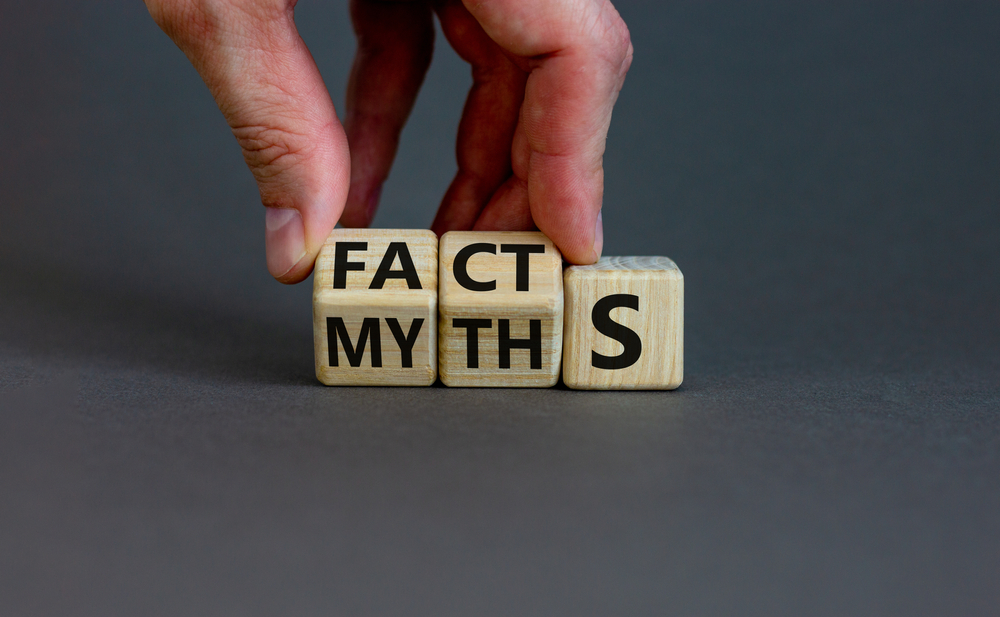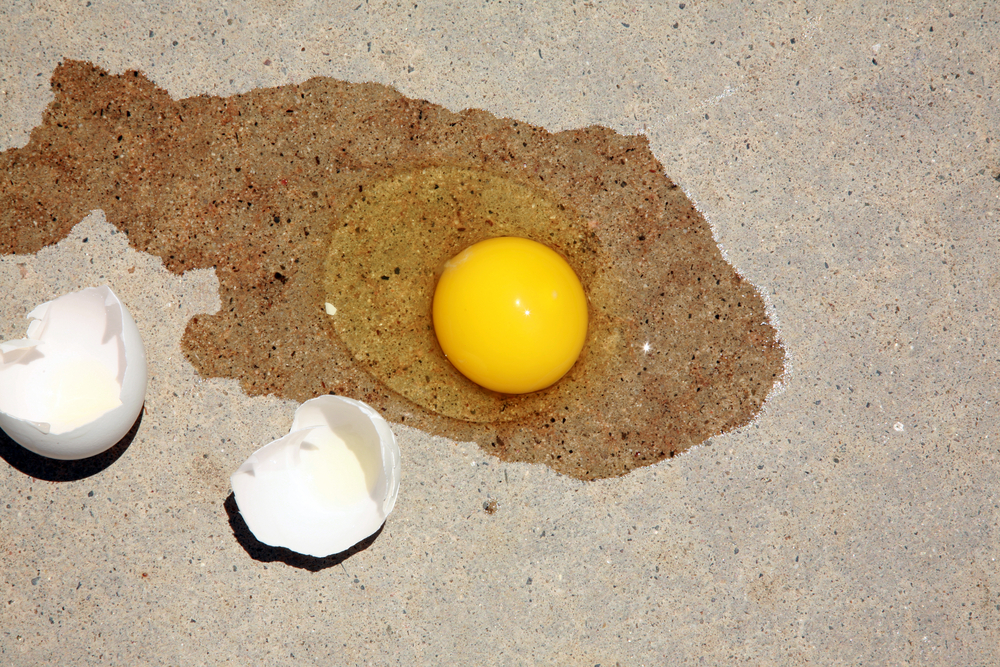Welcome to our ULTIMATE food myth guide!
When we’re talking about the foods we eat daily and the snacks we love, there are lots of so-called facts you’ve probably never thought to second-guess.
Green gummy bears are lime-flavored, German chocolate cake is from Germany, and the hens that lay cage-free eggs roam free on farms, right? Well, not really.
After all the years of being told false information by school friends, the media, and even some health care professionals (yep, even the experts might get fooled sometimes!), many people still think some of the most ordinary food myths are true.
So if you’ve always wondered if milk really does help build strong bones or if juice cleanses are as reliable as they seem, you’re in luck: Some major truth bombs are coming your way!
Here are 26 food myths you should probably stop believing…and some you’ve gotten right all along!

Chocolate Equals Stress Relief?
We’ve all heard the stereotype that women search for chocolate after a breakup, and maybe they’re not wrong. Studies show that chocolate can ease symptoms of premenstrual syndromes, including anxiety.
It’s even known to suppress feelings of fatigue and irritation. The mood-altering effects of chocolate are caused by a release of neurochemicals like serotonin, especially when mixed with carbs, as demonstrated by research involving brownies.
Consider this food myth: TRUE!
Is Chocolate An Aphrodisiac?
And while we’re still on the subject, the idea that it’s an aphrodisiac has been around since sometime in the 80s. That’s probably why box upon box has been flying off the shelves each February 14th.
Unfortunately, all those heart-shaped goodies have been more of a marketing scheme. Studies haven’t proven a single link between chocolates and a heightened libido, but that doesn’t mean the placebo effect isn’t still happening.
Since people choose to believe chocolate can help them amp up their bedroom life, they can sometimes make it happen simply by thinking about it. Whatever works, right?
What’s With The Five-Second Rule?
So you’ve dropped a piece of candy on the floor. You pick it up, dust it off, plop it in your mouth, and proudly proclaim: “Five-second rule!”
But, this rule…and especially the 10-second rule, are nothing but germy food myths! Germs can lock in on your wayward treats pretty fast. According to a study, bacteria can sometimes transfer to dropped food in under a second.
Researchers found that the more moist the food, the faster the bacteria transfer. For example, the watermelon they tested had the most contamination and gummy candies the least.
Can Eating Carrots Keep Your Eyes Healthy?
Remember growing up, everyone told us that eating carrots would help keep our eyes healthy?
Well, the funny thing is even though they’re super healthy for your body and contain that eye-boosting vitamin A, Harvard Medical School says that eating fresh fruits and dark leafy green vegetables is much better.
And they’re more beneficial options when it comes to your eye health. Consider THIS food myth debunked!
What’s The Big Whoop About Bottled Water?
Bottled water vendors capitalize on the fears of tap water contamination to the point of charging over 2,000 times as much for the same product. Studies have shown that tap water can be safer than bottled in some instances, so this food myth is just not true.
A few years ago, the nonprofit Center for Environmental Health reported that the Whole Foods and Dr. Pepper Snapple Group brands that were distributed in Walmarts and Targets contained enough arsenic to mandate a health warning under California law.
In fact, Consumer Reports showed that one brand had recalled thousands of cases for high levels of arsenic in 2016 but continued selling bottles under the federal limit that could still pose health risks if drunk regularly.
“Cage-free” means hens roam free, right?
Even if those hens DO happen to be “cage-free,” they may not necessarily have access to the outdoors. The term means they can roam “free” in a building, room, or open area instead of being kept in one of those battery cages.
So you might want to take THIS food myth with a grain of salt.
Does Honey Ever Expire?
When you’re doing a cleanout of your pantry, and you discover a plastic bear-shaped bottle of honey that’s been hibernating in the corner for a couple of years, you might be tempted to chuck it in the trash immediately.
But honey doesn’t actually expire! When you store it properly in sealed containers, it can remain stable for centuries! It might, however, crystallize or lose some of its aroma and flavor over time, which explains the expiration date.
So whatever you might have believed about this food myth, keep that honey in your home!
Grade “WHAT” Meat?
A typical food myth that’s been floating around for years is that the ground meat used by Taco Bell or other places, including school cafeterias, is labeled as “Grade D but Edible,” if not “Grade F.” But there is no letter grading system for meats in the US.
It operates on pass-fail guidelines, and optional USDA rankings range from “prime” to “canner.” As for Taco Bell meat, there’s no word on its ranking, just that it’s 88% beef, with the rest being typical additives and preservatives.
Are GMOs THAT Dangerous?
GMOs, Genetically Modified Foods, can do anything from preventing apples from browning too quickly to making corn become resistant to weed killers. They’ve also come with a good deal of debate as to whether they can cause any health issues.
So far, though, several health and science organizations have concluded they are safe. Does this food myth surprise you?
It Takes HOW LONG To Digest Gum?
Something that’s probably sent you directly into panic mode as a kid AND as an adult is accidentally swallowing your gum. It’s pretty widely known that it takes about 7 years to digest it, but the food myth just isn’t true.
When it comes to your digestive tract, gum doesn’t get special treatment. It goes in and comes out the exact way and speed any other food would.
Can Twinkies Outlast An Apocalypse?
Whether it’s “Family Guy,” “Zombieland,” or a Super Bowl ad, Twinkies are playfully recognized as not just indestructible but downright invincible, up there on the list of apocalypse survivors.
But this food myth is busted because even though they’re packed with artificial ingredients, the cream-filled yellow snacks have only one preservative and a shelf-life of 25 days, according to Hostess, their manufacturer.
Milk “Does A Body Good?”
Despite cafeterias serving those little cartons of milk with your school lunches and all those “Got Milk?” ads that promise strong bones, milk isn’t as good for you as you might have thought.
A study that was published by the journal Nutrition in Clinical Practice found that milk might be the reason bones actually LOSE calcium, doing the opposite of what it’s meant to.
On top of that, a different study published in the American Journal of Clinical Nutrition found that the rates of bone fractures were most increased in the countries that consumed the most dairy.
So maybe it’s time to switch to soy or almond, after all, because this food myth is completely FALSE.

Is German Chocolate Cake From Germany?
We hate to burst some of your bubbles on this one, but this food myth is FALSE! The yummy chocolate cake that’s made with coconut and pecans has no ties to Germany at all.
Instead, the name comes from Sam German, who, in 1852, created a particular kind of baking chocolate for Baker’s. The establishment named it “German’s chocolate,” and it was just shortened to “German Chocolate” over time.
Coca-Cola Used To Be Made With… Drugs?
The entire world’s most popular soda is the subject of so many urban food myths that it’s earned its own subcategory: Cokelore. One of the most apparent yet outlandish-sounding claims about Coca-Cola’s origins is based on truth: That it was made with cocaine.
In 1885, the soft drink was named for its advertised medicinal elements of coca leaves and kola nuts. The recipe was superficially connected to the ingredients just for the sake of branding for a time after.
It was cut down to a “mere trace” in 1891 and registered as six-100ths of an ounce per 25 million gallons of Coca-Cola syrup before being phased out completely in 1929.
How Many Flavors Do Froot Loops Have?
Is Toucan Sam a scammer?!? You’d think those multicolored loops would have a variety of flavors that match their colors. But, unfortunately, this food myth has been debunked! They’re all the same “frooty” flavor.
Studies confirmed this with a blind taste test and concluded that the loops tasted like sweetened cardboard, with little to no differences between them. But they don’t stop there…The same goes for Trix and Fruity Pebbles!
Can You Really Lose Weight By Being On A Juice Cleanse?
Year after year, women seem to spend hundreds of dollars on juice cleanses in hopes of shedding a few extra pounds. So what’s the problem? You don’t get long-lasting results, and they’re really horrible for your body. This food myth gets a thumb down from us.
Pop Rocks and Coke Killed ‘Little Mikey’
After Pop Rocks candy was released sometime in 1975, rumors arose that combining the “popping” candy with soda could be fatal and, in fact, killed “Little Mikey,” the child in the regular Life Cereal commercial.
Spoiler Alert: John Gilchrist, who played Little Mikey, is alive and well. And even though the company has taken out full-page ads explaining that Pop Rocks cause less gas than half a can of soda, General Foods is still putting up with farfetched rumors to this day.
We should probably put this food myth to bed!
Is Spam A Hawaiian Treat?
Spam is undoubtedly a fan favorite in Hawaii. So much so that on the company website’s FAQ page, one of the biggest questions is: “Why are Spam products so famous in Hawaii?”
The answer: Spam was served to GIs during World War II and became a part of the local cuisine. But the Hormel product first debuted in Austin, Minnesota. You can even visit the Spam Museum today and find restaurants and local diners with dishes incorporating it.
IS Organic food Better For Your Health?
If it’s more expensive, it HAS to be better for you, right? Well, not necessarily. Even though organic food is free of any herbicides and pesticides, there’s no evidence that it’s better for you than any other standard produce.
A 2012 study from Stanford looked into the difference between organic and non-organic foods and couldn’t find anything that proved the organic versions were any more nutritious or carried fewer health risks than the regular stuff we buy, even though people are paying so much more at the grocery store for it.
We say you should just eat your fruits and veggies and worry less about paying a premium.
Is Jell-O Made From Horse’s Hooves?
The jiggly treat, which makes up roughly 80% of the US gelatin market, does NOT come from hooves. So this food myth is debunked. But that doesn’t necessarily mean it’s vegetarian.
Rather, the gelatin that gives Jell-O its jiggly consistency is made from the hides and bones of animals, including pigs, cattle, and horses. It gets processed into collagen powder and, therefore, is not classified as an animal product by the federal government.
French Fries Are From France…Right?
According to National Geographic, the origin of French fries is a little twisted, but there’s solid evidence tracing them back to Belgium, not France. as many of us thought.
Locals along the River Meuse resorted to frying potatoes when the river froze, and they couldn’t fry fish. The golden, deep-fried potatoes aren’t even called French fries in France. They go by the alias “Pommes Frites.”
McDonald’s Uses WHAT Ingredients?
You didn’t really expect an article about food myths to NOT include McDonald’s, did you? Big food corporations are frequently viewed with skepticism, a common fear being that they hide gross or inedible-sounding fillers in products to cut down on costs.
And McDonald’s has been the main subject of countless allegations, including putting bird feathers in McFlurries, worm meat in burgers or styrofoam balls, and “eyeball fluid” in shakes.
None of these are true, but negative perceptions of the restaurants’ use of artificial ingredients have prompted them to start phasing out additives like high fructose corn syrup and preservatives.
Does Sugar Cause SO Much Destruction?
Dentists have always told you as a kid that candy rots your teeth. But this is technically a food myth because the same applies to healthier foods like fruit, bread, or even oatmeal.
All of these can cause plaque buildup and cavities if allowed to sit on your teeth for too long without flossing, brushing, or rinsing. Studies show that there also isn’t a significant link between sugar consumption and behavioral problems in children.
Parents’ reports of hyperactivity after kids drink soda is a matter of perception. And sugar is not primarily responsible for weight gain and obesity epidemics worldwide.
There’s no doubt that eating a lot of sugary snacks and sodas can pile on the pounds, but that’s because of too much calorie consumption, period, not specifically sugars.
Our bodies also transform starches into sugar, yet the nations that eat the most rice and pasta, Japan and Italy, are among the world’s thinnest.
Did Coffee Stunt YOUR Growth?
Your mom’s reason for wanting you to avoid coffee in high school doesn’t exactly check out on the food myth front. According to Harvard Medical School, despite the common belief that it stunts growth, there’s no distinction between whether you’re a growing kid or an adult.
Research has concluded that there’s no link between drinking coffee and osteoporosis, which can reduce your height.

Could You REALLY Fry An Egg On A Sidewalk?
We’re sure you’ve heard the expression, “it’s so hot out you could fry an egg on the sidewalk.” But have you ever wondered how valid this food myth was? Or better yet…have you tried it?
According to the Library of Congress, cooking an egg on the sidewalk would be challenging because it’s a poor heat conductor. An egg needs heat about as high as 158 degrees to cook through, and a hot sidewalk might only get up to about 145 degrees Fahrenheit.
Can Eating Smaller Meals Boost Your Metabolism?
When trying to boost your metabolism, it’s not uncommon to come across some advice to eat smaller portions throughout your day. Unfortunately, though, there’s no proof that it works.
A study published in the journal “Obesity” found no difference in one’s metabolism when comparing those who ate six smaller meals with those who consumed three normal-sized meals per day.
The people who ate the smaller meals tended to be hungrier than those who didn’t, increasing their desire to eat. So…food myth obviously debunked!
So there you have it, folks! How many of these food myths did you grow up believing? Let us know in the comments below.
If you’re looking for some SENSIBLE advice on nutrition, we’ve got you covered. We highly suggest reading: Cutting Down on Processed Food? Here Are 7 PRACTICAL Ways to Do It








